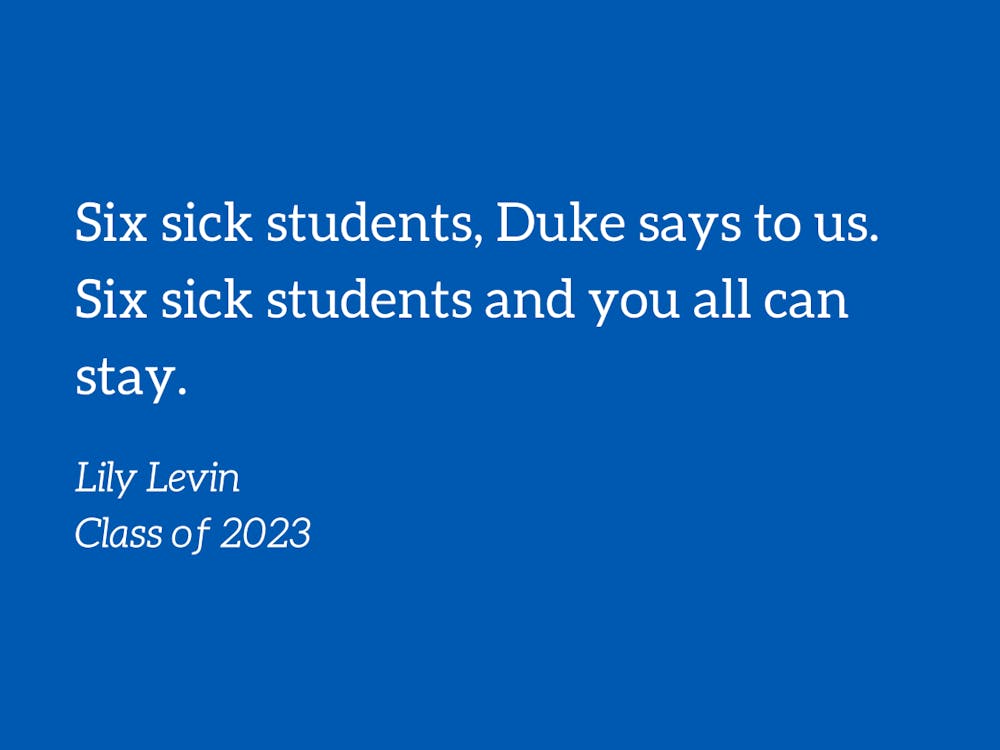When I was a wee elementary-schooler, I was obsessed with National Geographic’s Weird but True fact books. Naturally, I learned many niche scientific and sociopolitical facts that would never, ever be relevant to my life. For example, consider the following:
The number of seconds in an average human yawn? Six.
The number of months a mother Octopus spends protecting her 56,000 eggs? Six.
The number of inches the Eiffel Tower can expand during the summer? Six.
The number of Duke students testing positive for coronavirus almost every week? Six.
Oh, wait.
After scanning the fourth factoid in my Duke-curated National Geographic flipbook (don’t ask questions), I suspiciously scrolled through Duke’s breakdown in the coronavirus testing tracker. The consistency of six within the COVID results was most definitely weird, and it certainly could not be true.
Sadly, however, National Geographic typically provides expert-checked information: September 12-18th, August 29th-September 4th, August 22-28th all saw six students test positive for COVID. September 5-11th only had five positives (I will address that disparity in a moment).
The likelihood of the same number of students testing positive every week is marginal, almost nonexistent. The likelihood of the same number of students testing positive three out of the four weeks of testing is questionable, and a bit more believable. But maybe not believable enough, Nancy Drew, third-grade Lily whispered in my ear.
My critical thinking skills were suddenly put to the test. I embarked on a dangerous quest through the labyrinth of Duke’s COVID tracker. The journey was self-righteous enough—I wanted to be regarded as the Hero Who Discovered That The Positives Were Fabricated, and also profoundly selfless—I wanted to be regarded as the Martyr Who Discovered That The Positives Were Fabricated. (I know, after leaking this story, that I’ll be shipped away to the underground tunnels and also terminated from my RA position; I might as well admit what I have to lose.)
To be honest, I didn’t find much. Nevertheless, my few realizations were shocking (you already know I have an interview with Daily Mail).
Realization #1: After hours of poring through academic and scholarly articles, I learned that six is the smallest perfect number, meaning that it’s equal to the sum of its divisors. The Duke administration could not report 0 cases of coronavirus every week; they’d have Fauci-clones tracing their paper trail. Instead, the Board of Trustees meticulously calculated a value that was not too large, not too small, but just in between (and three numeric values less than the million-dollar amount of Coach K’s salary): six. It was truly nothing short of effortless perfection. And the ambiguous five was placed in the middle so as not to explicitly show pattern. Brilliant. Despite the drop in Duke’s ranking, it was nothing short of what was expected from the university.
Realization #2: Duke’s mascot is the Blue Devil. Six students have tested positive for three weeks. What’s three sixes in a row? You figure it out.
Realization #3: In fact, there’s symbolism everywhere, as it turns out. Duke forest is divided into six sections. West Campus contains six quadrangles (at least according to Wikipedia; I haven’t actually counted). Duke Alumni magazine is published six times per year. D-U-K-E-U-N (Un for University) consists of six letters. There are six months in a half-year. Et cetera, et cetera, et cetera.
***
In all seriousness, I am still giving Duke the benefit of the doubt. I’m still hoping that our testing tracker stays low. Because Duke was, and still is, taking a huge gamble by reopening: we’re putting the lives of students, staff, faculty and the surrounding community on the line. Duke is not unique to this phenomenon—it’s nation-wide and likely impossible for one institution to circumvent—but by resuming work, labor and productivity, we’re telling our bodies and brains to digest what is unpalatable. We’re saying, even though we’re living through a time of collective grief and trauma, a B on that test will still keep us out of our dream graduate school. We’re saying, even though the United States has surpassed 200,000 COVID deaths, minimum wage labor without the proper PPE is acceptable. We’re saying, We are barely surviving but six positives is comforting, unchanging, good enough.
I want six to be reassuring. I want to tell myself that even though the reopening of colleges nationwide has caused thousands of new cases per day, Duke is different. We have six. We have six because we also have copious amounts of money and resources for testing two-times-per-week and distancing and isolation, when some of our neighbors in Durham cannot access affordable healthcare.
Six sick students, Duke says to us. Six sick students and you all can stay, Duke says to us. Six sick students at the expense of maybe a few lives of Durham residents, a handful of gentrified apartments, the health of many older workers.
It’s weird and maybe even unprecedented, Duke says to us, but it’s true.
Lily Levin is a Trinity sophomore. Her column runs on alternate Thursdays.
Get The Chronicle straight to your inbox
Signup for our weekly newsletter. Cancel at any time.

